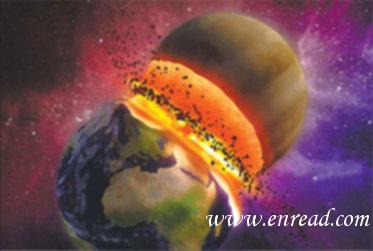| ||||||||||||||||||||||||||||||||||||||||||||||||||||||||||||||||||||||||||||||||||||||||||||||||||||||||||||||||||||||||
|
最新一期英国《自然》期刊上的研究报告称,一种叫做“轨道混沌”的力量可能致使地球与金星、火星等相撞,从而引发太阳系混乱。不过,这种混乱出现几率约为1/2500,且在35亿年内不会发生。上述研究结果是巴黎检测中心研究人员使用计算机数字模拟技术,对未来50亿年太阳系星球轨道不稳定性进行了上百次模拟实验后得出的。 A force known as orbital chaos2 may cause our Solar System to go haywire, leading to possible collision between Earth and Venus or Mars, according to a study released Wednesday. The good news is that the likelihood of such a smash-up is small, around one-in-2500. And even if the planets did careen into one another, it would not happen before another 3.5 billion years. Indeed, there is a 99 percent chance that the Sun's posse of planets will continue to circle in an orderly pattern throughout the expected life span of our life-giving star, another five billion years, the study found. After that, the Sun will likely expand into a red giant, engulfing3 Earth and its other inner planets -- Mercury, Venus and Mars -- in the process. Astronomers4 have long been able to calculate the movement of planets with great accuracy hundreds, even thousands of years in advance. This is how eclipses have been predicted. But peering further into the future of celestial5 mechanics with exactitude is still beyond our reach, said Jacques Laskar, a researcher at the Observatoire de Paris and lead author of the study. "The most precise long-term solutions for the orbital motion of the Solar System are not valid6 over more than a few tens of millions of years," he said in an interview. Using powerful computers, Laskar and colleague Mickael Gastineau generated numerical simulations of orbital instability over the next five billion years. Unlike previous models, they took into account Albert Einstein's theory of general relativity. Over a short time span, this made little difference, but over the long haul it resulted in dramatically different orbital paths. The researchers looked at 2,501 possible scenarios8, 25 of which ended with a severely9 disrupted Solar System. "There is one scenario7 in which Mars passes very close to Earth," 794 kilometres (493 miles) to be exact, said Laskar. "When you come that close, it is almost the same as a collision because the planets gets torn apart." Life on Earth, if there still were any, would almost certainly cease to exist. To get a more fine-grained view of how this might unfold, Laskar and Gastineau ran an additional two hundred computer models, slightly changing the path of Mars each time. All but five of them ended in a two-way collision involving the Sun, Earth, Mercury, Venus or Mars. A quarter of them saw Earth smashed to pieces. The key to all the scenarios of extreme orbital chaos was the rock closest to the Sun, found the study, published in the British journal Nature. "Mercury is the trigger, and would be be the first planet to be destabilised because it has the smallest mass," explained Laskar. At some point Mercury's orbit would get into resonance10 with that of Jupiter, throwing the smaller orb1 even more out of kilter, he said. Once this happens, the so-called "angular momentum11" from the much larger Jupiter would wreak12 havoc13 on the other inner planets' orbits too. "The simulations indicate that Mercury, in spite of its diminutive14 size, poses the greatest risk to our present order," noted15 University of California scientists Gregory Laughlin in a commentary, also published in Nature. 点击  收听单词发音 收听单词发音
|
||||||||||||||||||||||||||||||||||||||||||||||||||||||||||||||||||||||||||||||||||||||||||||||||||||||||||||||||||||||||
- 发表评论
-
- 最新评论 进入详细评论页>>




